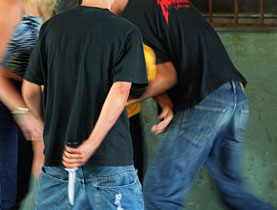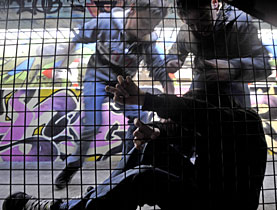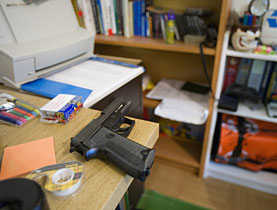Young knife-carriers on the rise in Geneva

An increasing number of youngsters in canton Geneva are carrying knives to protect themselves, according to the author of a study into knives and adolescents.
While the phenomenon is still “marginal”, it cannot be excluded that it will take the same direction as in countries including Britain, said psychologist Stephan Wenger.
He was the lead author of a study by the Geneva-based Païdos youth support association, in which 75 per cent of youngsters questioned said knife-carrying had increased and a quarter admitted to owning a knife.
The study among 200 young people aged 15-20 from different parts of Geneva was prompted following a number of knife incidents at the Païdos association in Geneva.
Among the 49 people who said they had a knife, 60 per cent said they carried it occasionally, while 40 per cent said they often had it on them, especially at night in town but only rarely (2 per cent) at school.
Some 58 per cent of those questioned said they had witnessed individual or gang fights where knives had been used, and 25 per cent of them had already used a knife in a fight.
“While objectively we have no other study to compare our figures with, my feeling from working in the field with young people is that the phenomenon is increasing but still remains marginal,” Wenger told swissinfo.
“More and more kids are carrying knives or other weapons, but for the moment there is not a growth in their use.”
Police and hospitals
The local police and medical services seem to acknowledge the trend.
Geneva cantonal police statistics show the number of incidents of grievous bodily harm, involving all weapons including knives, rose by 12.8 per cent between 2006 and 2007.
“It’s a growing trend; more and more young people carry a knife in their pockets,” police spokesman Patrick Puhl told swissinfo.
“Often fights break out where a knife is drawn resulting in serious or even fatal accidents, such as the young lad who was stabbed to death following a fight at the Fêtes de Genève festival two years ago.”
And more recently in September a 19-year-old boy died at the Geneva’s University Hospital (HUG) after being stabbed in the head following a gang fight in Cluses in neighbouring France.
“We haven’t noticed any specific increase,” said Elisabeth Andereggen, head of surgery at the HUG’s Accident and Emergency. “But in 2007, 52 youngsters were injured in knife attacks – around one a week.”
Why, why, why?
Almost three-quarters of those questioned said they carried a knife for defence purposes, but 65 per cent said they didn’t feel safer as a result of having a knife on them.
“It’s a mixture of status, fashion and more functional reasons,” said Wenger. “Some of the kids we asked said they carried a knife to show off, while others said they carried one as they didn’t feel safe.”
“Those who carried a knife said, ‘When you carry one you are stronger, more courageous and it’s normal as life is risky, and you scare others, so you feel a bit more dominant in the relationship’.”
The normally vulnerable, powerless kids who start carrying knives then find themselves unable to do without one, added the psychologist.
More paranoid
For Wenger and the association, this is the most worrying group.
“Most of them have difficult family situations, are in conflict, without projects or hope,” he said.
“They feel that even if they exist, society won’t change anything for them, as there is no work or perspectives. There are lots of kids like that in Geneva.”
Additional efforts and resources are needed to strengthen socio-educational and psychotherapeutic institutions and alternative school projects that look after kids, he said.
Especially as the more fragile children are becoming more “paranoid” and harder to get through to, he added.
“It’s much harder to talk to them about what they are suffering inside,” said Wenger.
By exteriorising pain and hurt, youngsters find problems easier to deal with, thus creating enemies and the need to carry weapons, he added.
“I don’t think repression or sanctions will change much for this group of adolescents,” he said.
And is the carrying of knives set to get worse, like in Britain?
“We could imagine that we are taking the same direction as other countries, like Britain, but not the same proportions as over there,” he said.
“After a while the phenomenon will slowly peter out and kids will find another way of defending themselves. Whether it actually does diminish or whether we have a big disaster beforehand, I can’t really answer that one,” said Wenger.
swissinfo, Simon Bradley in Geneva
14,045 youths (79.5% boys) were convicted of crimes in 2006, according to the Federal Statistics Office. That is up about 2,000 from 1999.
64.1% of youths convicted are Swiss.
Convictions for driving offences, attacks against people and property-related crimes have been increasing since 1999, while drug-related offences have dropped.
Police figures suggest violent youth crimes have doubled in the past eight years, but researchers say they view the numbers with caution.
Studies in Switzerland, Germany, the Netherlands and Sweden suggest people are reporting more crimes than before.
Britain has recently witnessed a spate of fatal knife attacks, which have sparked a debate about youth violence and gang culture in the country. In all, 54 teenagers have been murdered in London over the past two years, mostly stabbed to death.
In Spain 135 people died from knife injuries in 2007 and nearly 488,000 knives were confiscated by police. But those figures do not represent any significant change compared to previous years and guns remain the preferred lethal weapon. There is not a wave of knife crime and it does not seem to overly preoccupy the authorities or the wider community.
In Japan there is great concern about what is perceived to be a rising level of knife crime. Reports suggest that in 2007 there were 40% more knife crimes than there were five years earlier. But the numbers were still pretty low compared to other countries – fewer than 5,000 violations of the knife crime law in a country of more than 127 million people.
In Denmark there are strict rules as to the length of knives that can be carried in public and police have broad powers to search individuals without due cause. Despite these measures, the level of crime in which knives are involved has remained the same – 2-3% of all violent crime.
France has seen no equivalent of the wave of fatal stabbings in Britain. But according to Alain Bauer, France’s leading criminologist, the carrying of knives and other weapons by adolescents is widespread in many poor neighbourhoods.
And if the number of murders nationwide remains relatively low (on average around 1,000 a year, of which only about 35 by minors), there has been a huge increase recently in acts of violence carried out by minors. According to Bauer, France hasn’t reached the point where knife-carriers move to the actual deed. “But it’s probably only a question of time.”

In compliance with the JTI standards
More: SWI swissinfo.ch certified by the Journalism Trust Initiative




You can find an overview of ongoing debates with our journalists here. Please join us!
If you want to start a conversation about a topic raised in this article or want to report factual errors, email us at english@swissinfo.ch.